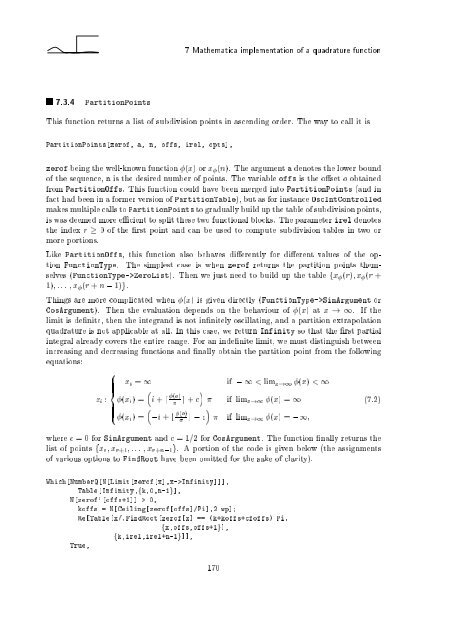Wave Propagation in Linear Media | re-examined
Wave Propagation in Linear Media | re-examined
Wave Propagation in Linear Media | re-examined
Create successful ePaper yourself
Turn your PDF publications into a flip-book with our unique Google optimized e-Paper software.
7.3.4 PartitionPo<strong>in</strong>ts<br />
7 Mathematica implementation of a quadratu<strong>re</strong> function<br />
This function <strong>re</strong>turns a list of subdivision po<strong>in</strong>ts <strong>in</strong> ascend<strong>in</strong>g order. The way to call it is<br />
PartitionPo<strong>in</strong>ts[zerof, a, n, offs, i<strong>re</strong>l, opts],<br />
zerof be<strong>in</strong>g the well-known function (x) orx (n). The argument a denotes the lower bound<br />
of the sequence, n is the desi<strong>re</strong>d number of po<strong>in</strong>ts. The variable offs is the o set o obta<strong>in</strong>ed<br />
from PartitionOffs. This function could have been merged <strong>in</strong>to PartitionPo<strong>in</strong>ts (and <strong>in</strong><br />
fact had been <strong>in</strong> a former version of PartitionTable), but as for <strong>in</strong>stance OscIntControlled<br />
makes multiple calls to PartitionPo<strong>in</strong>ts to gradually build up the table of subdivision po<strong>in</strong>ts,<br />
is was deemed mo<strong>re</strong> e cient to split these two functional blocks. The parameter i<strong>re</strong>l denotes<br />
the <strong>in</strong>dex r 0 of the rst po<strong>in</strong>t and can be used to compute subdivision tables <strong>in</strong> two or<br />
mo<strong>re</strong> portions.<br />
Like PartitionOffs, this function also behaves di e<strong>re</strong>ntly for di e<strong>re</strong>nt values of the option<br />
FunctionType. The simplest case is when zerof <strong>re</strong>turns the partition po<strong>in</strong>ts themselves<br />
(FunctionType->ZeroList). Then we just need to build up the table fx (r);x (r+<br />
1);::: ;x (r+n,1)g.<br />
Th<strong>in</strong>gs a<strong>re</strong> mo<strong>re</strong> complicated when (x) is given di<strong>re</strong>ctly (FunctionType->S<strong>in</strong>Argument or<br />
CosArgument). Then the evaluation depends on the behaviour of (x) at x ! 1. If the<br />
limit is de nite, then the <strong>in</strong>tegrand is not <strong>in</strong> nitely oscillat<strong>in</strong>g, and a partition extrapolation<br />
quadratu<strong>re</strong> is not applicable at all. In this case, we <strong>re</strong>turn Inf<strong>in</strong>ity so that the rst partial<br />
<strong>in</strong>tegral al<strong>re</strong>ady covers the enti<strong>re</strong> range. For an <strong>in</strong>de nite limit, we must dist<strong>in</strong>guish between<br />
<strong>in</strong>c<strong>re</strong>as<strong>in</strong>g and dec<strong>re</strong>as<strong>in</strong>g functions and nally obta<strong>in</strong> the partition po<strong>in</strong>t from the follow<strong>in</strong>g<br />
equations:<br />
zi :<br />
8<br />
><<br />
>:<br />
xi = 1 if ,1Inf<strong>in</strong>ity]]],<br />
Table[Inf<strong>in</strong>ity,fk,0,n-1g],<br />
N[zerof'[offs+1]] > 0,<br />
koffs = N[Ceil<strong>in</strong>g[zerof[offs]/Pi],2 wp];<br />
Re[Table[x/.F<strong>in</strong>dRoot[zerof[x] == (k+koffs+cfoffs) Pi,<br />
fx,offs,offs+1g],<br />
fk,i<strong>re</strong>l,i<strong>re</strong>l+n-1g]],<br />
True,<br />
170<br />
(7.2)












